All about polycarbonate colors
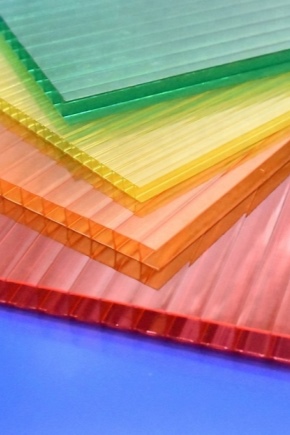
Polycarbonate is a modern building material that is resistant to various temperatures, strength, flexibility, increased heat and noise insulation. At the same time, polycarbonate sheets transmit light well and are quite lightweight. The thickness and dimensions of the sheets may vary. It is worth noting that the modern line of this material is characterized by a variety of colors. This allows it to be widely used in the construction of various objects, as well as in design.
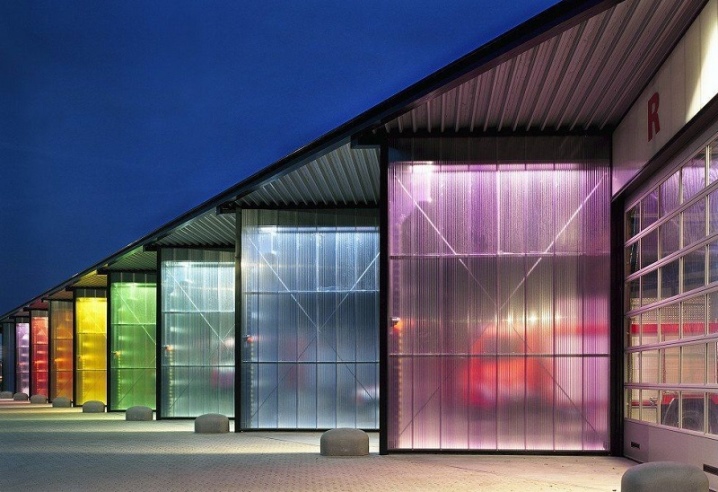
Texture
Currently, there are 2 types of polycarbonate: cellular and monolithic.
- Honeycomb sheet consists of two thin sheets, between which stiffeners are installed. It should be clarified that according to the number of chambers, sheets can be two-, three- and four-chambered. There are also options with a reinforced structure. Honeycomb sheets with the effect of blinds are unusual. The thickness of polycarbonate sheets can vary greatly. However, the most popular canvases were 4-16 millimeters thick, as well as 20-32 millimeters thick. As for the size of the sheets, their average width is 2.05-2.1 meters, and the length is from 3 to 12 meters.
Most often, special layers are applied to the top side of the sheet in order to improve transmittance and make light diffusion more uniform.
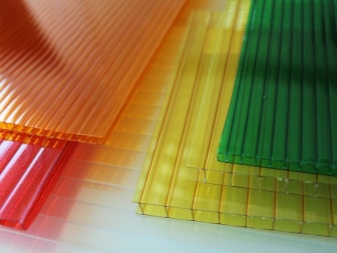

- Monolithic sheet is solid, and looks like silicate glass. However, it is more durable and better tolerates mechanical damage. Polycarbonate of this type can be smooth, textured or profiled. Smooth has good light transmittance, which is almost as good as glass. Among its advantages, it should be noted the possibility of thermoforming. You can bend such a panel both cold and hot.
All kinds of patterns can be depicted on the surface.
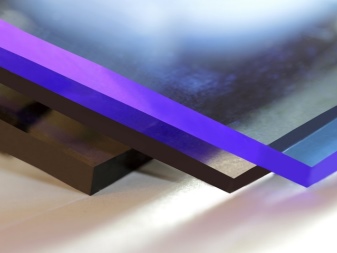
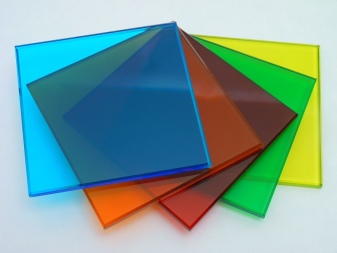
Textured or textured polycarbonate is a sheet that has various embossings. Most often, you can see such types of patterns as shagreen, crushed ice, prismatic. Profiled panels differ waves in the form of trapeziums... In their appearance, they resemble plastic corrugated board and are excellent as roofing material.
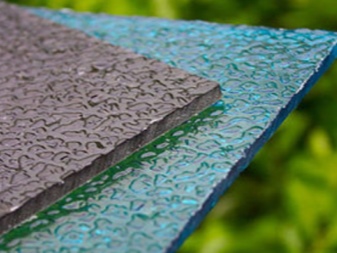
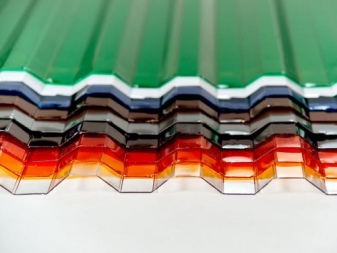
Light shades
Among the variety of colors of polycarbonate sheets, it became especially recognizable transparent... Such panels are completely colorless and transmit light best of all. The light transmission of this polycarbonate is 86%. That is why panels are used where this property is important.
They are suitable for building greenhouses, greenhouses and the like. Approximately 90 percent of the transparent polycarbonate sold is used for such purposes. The remaining 10 percent is used as glass for canopies and other places where fragile material needs to be replaced.
The colorless option is perfect for partitions in the office or in the house, conventionally dividing zones.
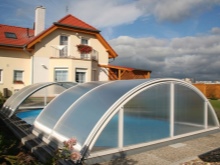
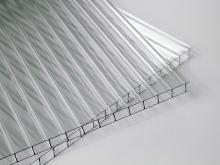
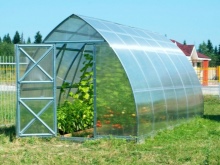
The palette of sheets with good light transmission is distinguished by a variety of colors. For example, White monolithic polycarbonate will also transmit sunlight well (60% light transmission). Such a sheet is suitable for those places that need to be protected from rain and wind. However, it should be borne in mind that such panels will not provide sufficient protection against UV radiation.
Lactic has a lower light transmission (within 30 percent). Although this color is light, it is opaque.Therefore, it can be, like pearl or silver, can be safely used for full-fledged sheds and even gazebos.
Also in this regard, a rich gray color is good.
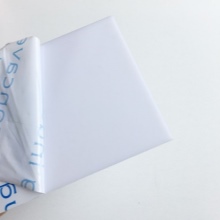
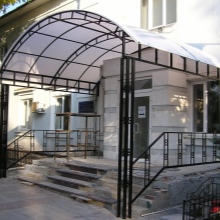

Many people like colored cellular polycarbonate, as it differs in a variety of shades. In the palette, you can find sheets of a wide variety of colors, including both traditional ones and more noble and interesting ones. For example, the panels will look very original. terracotta shade.
Moreover, such material is suitable both for improving the design of the premises, and for the construction of independent objects.
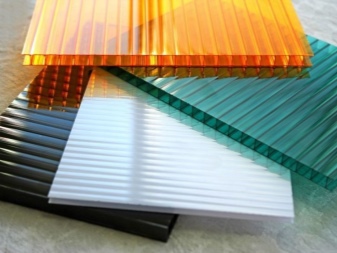
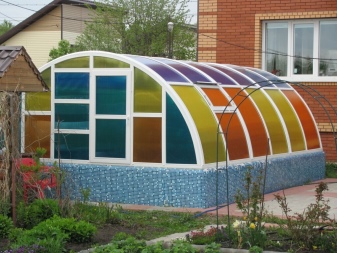
It should be noted that the technology for painting polycarbonate sheets is the same for any color. However, some shades may still have higher retail prices. A prime example is bronze polycarbonate. Perhaps this is due to the fact that its soft and warm shade creates pleasant lighting and will be appropriate in many places.
Bronze is distinguished by nobility and tranquility, therefore this color is widely used for decoration of commercial and various office objects. It is also widely used in home interiors. Bronze polycarbonate comes in various textures, which allows it to be used for windows, doors, partitions, canopies, and roofs.
Bronze shades look great when decorating facades. They are in perfect harmony with the landscape, giving the building an expensive and solid look.
Often, outbuildings and garages are erected from sheets of this color to give them elegance and protect objects from excessive sunlight (burnout).
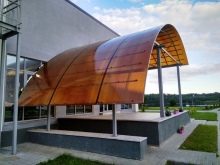
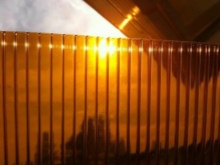
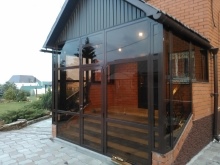
Bright colors
Those who want to bring as many bright colors as possible with polycarbonate should take a closer look at translucent panels. Their throughput is 40-45 percent. The great advantage of these colors is that they leave pleasant hues inside buildings and do not have a negative effect on the mental state.
Turquoise, yellow, green, orange, red, blue, blue will look good on buildings in which people will constantly be. For example, turquoise is great for an indoor pool. This color gives the water a marine tint and promotes relaxation.
It is also good to use aqua polycarbonate for these purposes.
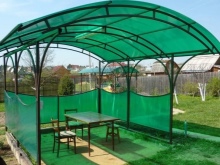
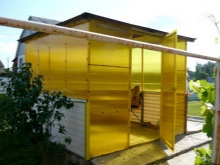
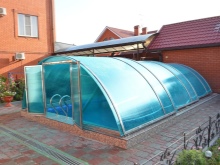
Blue can dim bright sunlight and create beautiful lighting. It is often used to decorate balconies or bus stops. Shades of blue, like purple, have a positive effect on photosynthesis, therefore, they are often used to decorate winter gardens and greenhouses.

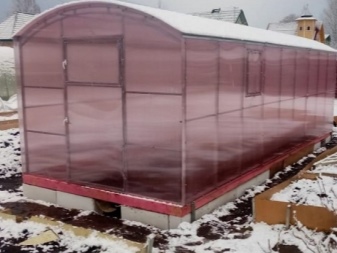
You should be a little more careful with red panels. For example, opaque sheets can be overly saturated and cause feelings of anxiety and anxiety. This material is best used for technical structures. The translucent version of this color, like orange, is often used for greenhouses, as it promotes plant growth.
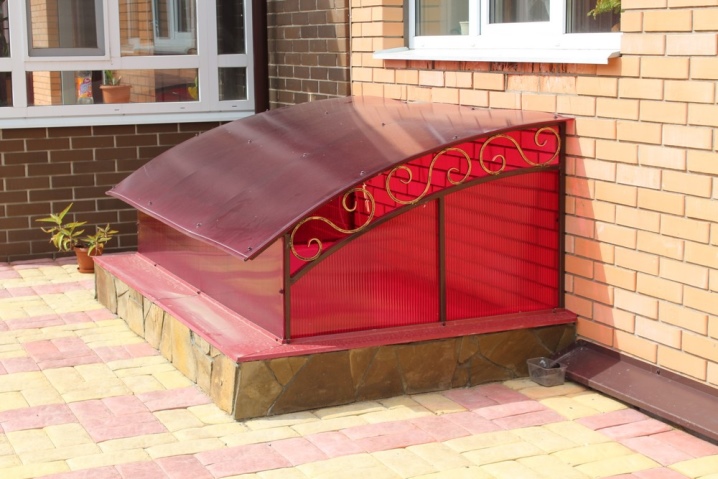
It is worth noting that multi-colored polycarbonate can be used by mixing sheets of different tones. For example, a gazebo in which green and yellow shades are combined will look very interesting. No matter how much the shades of green are liked by summer residents, you should not use them for buildings where plants will be located. This is due to the fact that this color negatively affects the process of photosynthesis. As a result, the plants will be very weak.
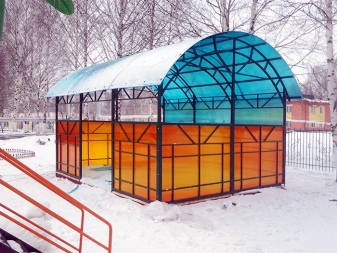

If you want to install a polycarbonate structure on that part of the site where there is no shade, then it is better to choose an amber color. Amber, like gold and silver, has a low light transmittance. These shades can be used for gazebos, workshops and other buildings.
An excellent solution would be a polycarbonate fence of any bright color. Look great orange, blue and red options... Various shades also look very impressive. green.
It is worth noting that if you choose honeycomb panels, they will also absorb extraneous sounds.
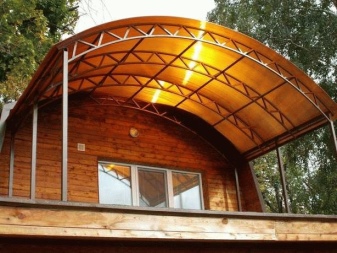
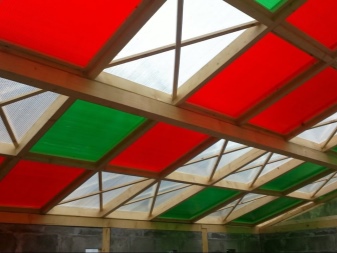
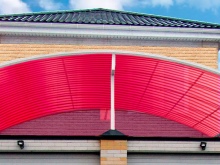
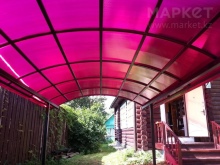
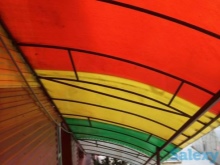
Dark colors
Brown and black colors for polycarbonate, they began to be used quite recently, but they quickly gained popularity. So, they are widely used to create the bottom of the walls, as well as closed verandas and terraces, gazebos. Elements in the interior look very original, for example, lighting fixtures, stained-glass windows, screens, interior doors, and so on. Playing on contrast, you can highlight part of the space or, conversely, choose a shade so that it looks harmonious with other elements.
It should be clarified that dark colors allow only 25-30 percent of the light to pass through. This allows it to be used for buildings that should not get too hot in the sun. Not surprisingly, dark shades are popular in industry, construction, and agriculture. Designers also note that noble colors, such as shades of chocolate, are very popular in interiors. Often you can find among the decorative elements of polycarbonate dishes or pomegranate-colored vases.
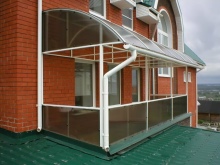
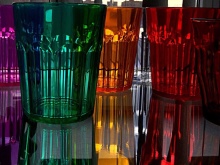
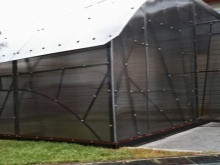
Quite often, on the streets you can see public transport stops, glazed pedestrian crossings, canopies at stops made of dark polycarbonate. Sheet material of these colors is distinguished by high strength, low thermal conductivity, frost resistance, good flexibility, deformation resistance, fire safety.
Dark panels are usually UV-protected. This allows them to be used for summer buildings, so as not to get heat or sunstroke.
This option is perfect where you need to escape the heat.
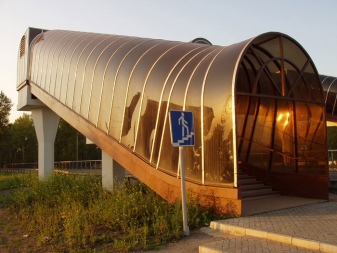
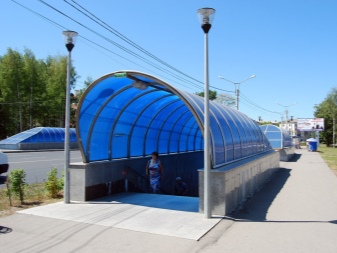
The following video will tell you what you need to know when choosing cellular polycarbonate.













The comment was sent successfully.